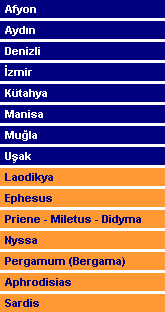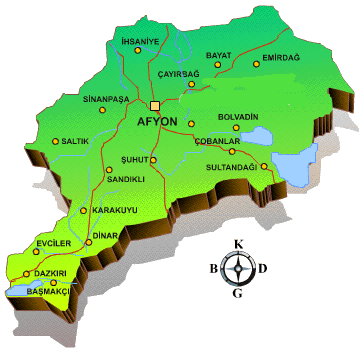| Afyon... |
|
The province is located as a gateway between the sea and inner regions of Anatolia. The history of Afyon goes back to
4000 BC. The city is famous for its specific "Turkish Delight" and "Kaymak", a kind of hard cream
put on desserts, which one should certainly taste at least once. Afyon is a spa-center with thermal baths in Gazi Kaplicasi
(25 km northwest), Gecek and Omerli Kaplicalari (18 km and 15 km northwest respectively), and Hudai Kaplicasi 73 km
southwest of the town, Sandikli which is also famous for its mud baths, too. All these resorts have board and lodging
facilities. The Archaeological Museum and the War of Independence Memorial are places to visit in the city and to the
north of Afyon there are Phrygian remains in the form of monumental cult rocks. Aslantas and Aslankaya are the largest
of these. The lion reliefs, which gave the name to these rocks are seen on sides of the rock and cult temples. Afyon
Citadel which was built during the Byzantine period previously was used as a fortress by the Hittite King Mursil II,
is another monument to see in the city. The town of Dazkin on the Denizli highway is famous for its carpets and kilims.
Formerly called Afyonkarahisar (The Black Fortress of Opium), this workaday agricultural and carpet - weaving town (at
an altitude of 1,015 m) and capital of the province of the same name, hardly lives up to its sinister moniker. There is
indeed a steep hill, crowned with a fortress, in the historic centre of town. This is still an important region for
producing legal opium for legitimate pharmaceutical use. But Afyon's claim to fame among Turks is its "Afyon Kaymagi" or
clotted cream. An old Turkish saying advises one to "eat sweetly and speak sweetly". Sweets and desserts have always been
an important and distinctive element of Turkish cuisine. That was true in Ottoman times and is just as true today.
Interestingly enough however, they also fulfill an important social and ritual function. Halvah, a confection made from
semolina, is offered on the occasion of major changes in people's lives: a birth, a death, induction into the army,
return from pilgrimage, upon settling in a new home, enrolling and graduating school; and also on special occasions such
as praying for rain. One of the most important holidays in the traditional calendar is the one that marks the end of the
30-day period of daytime fasting during the month of Ramazan. A popular Turkish name for the Ramazan festival is "Seker
Bayrami" (literally "Sugar Holiday'), which is a sort of caps-tone to the lavish desserts prepared for the sundown meals
|
|

|


 272...
272...
 03...
03...
 812,416...
812,416...
 14,230...
14,230...
 30 E 33 - 38 N 45...
30 E 33 - 38 N 45...



